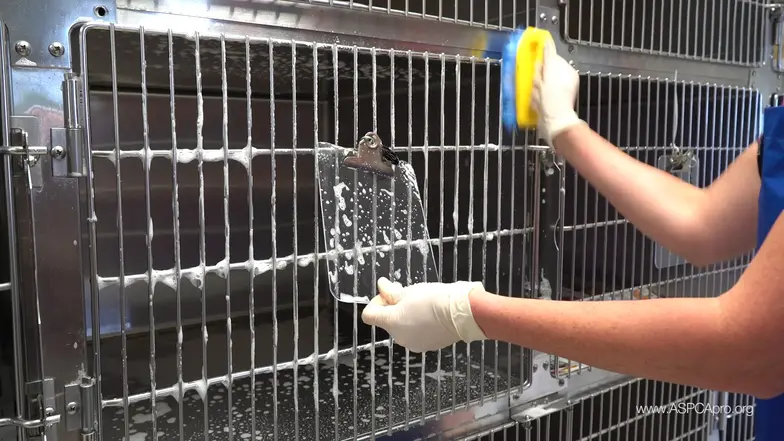5 Quick Shelter Sanitation Tips

1. Sanitation is a 2-Step Process
For effective shelter cleaning, use a 2-step sanitation process: cleaning and disinfection. First, manually remove dirt, feces, and organic matter. Then, apply a disinfectant to kill viruses and bacteria. Always clean before disinfecting.
2. Utilize Spot Cleaning
Spot cleaning is recommended when an animal's enclosure isn't visibly dirty and the same animal will continue to be housed in the enclosure. This reduces animal stress and handling, conserves cleaning supplies and boosts efficiency. Focus on areas that need attention, and save time on non-contaminated surfaces.
Watch these videos to learn proper techniques for spot cleaning:
3. Use Dish Soap for the Cleaning Step
Some disinfectants (e.g. Rescue™) can be used as both the cleaner and the disinfectant in the 2-step process. (See Shelter Disinfectant Quick Reference.) However, shelters can save resources by using less costly dish soap for the cleaning step in the shelter sanitation process. After scrubbing, rinse off soap and debris, then apply disinfectant to finish. This helps clean animal kennels without overusing disinfectant.
4. Choose the Appropriate Concentration of Disinfectant
Some disinfectants can be used at varying concentrations and contact times, depending on the desired effect. Shelters should use a concentration of disinfectant that is effective against parvovirus, panleukopenia, and calicivirus (non-enveloped viruses) in areas where animals are examined, housed or walked. For example, Rescue™ can be used at 1:32 dilution for a 10-minute contact time or at 1:16 dilution for a 5-minute contact time. The less concentrated dilution will conserve a shelter’s supply of disinfectant but may increase staff time needed to accomplish sanitation. Wall-mounted dilution stations for commercial disinfectants and hose-end foamers (with specified metering tip in place) help shelters utilize effective product concentrations. Periodic use of Precise Indicator Strips™ ensures that an appropriate concentration of Rescue™ is being applied to surfaces.
5. Don’t Forget Sanitation in Foster Homes
Foster homes allow shelters to increase their capacity to care for animals. They are an extension of the shelter, so proper cleaning procedures should be followed. Dish detergent should be used to clean enclosures, bowls, litter pans and toys prior to application of a suitable disinfectant. Since it has become easier to obtain, foster homes (just like shelters) can utilize Rescue™ as a disinfectant. As an alternative, household bleach diluted with water (1/2 cup bleach to 1 gallon water) can be used as a disinfectant, but only after all organic material has been removed.
We have lots more on this subject:

